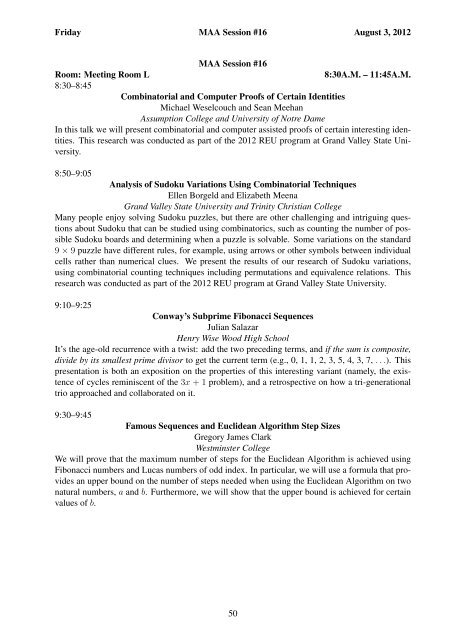Pi Mu Epsilon - Mathematical Association of America
Pi Mu Epsilon - Mathematical Association of America
Pi Mu Epsilon - Mathematical Association of America
Create successful ePaper yourself
Turn your PDF publications into a flip-book with our unique Google optimized e-Paper software.
Friday MAA Session #16 August 3, 2012<br />
MAA Session #16<br />
Room: Meeting Room L<br />
8:30A.M. – 11:45A.M.<br />
8:30–8:45<br />
Combinatorial and Computer Pro<strong>of</strong>s <strong>of</strong> Certain Identities<br />
Michael Weselcouch and Sean Meehan<br />
Assumption College and University <strong>of</strong> Notre Dame<br />
In this talk we will present combinatorial and computer assisted pro<strong>of</strong>s <strong>of</strong> certain interesting identities.<br />
This research was conducted as part <strong>of</strong> the 2012 REU program at Grand Valley State University.<br />
8:50–9:05<br />
Analysis <strong>of</strong> Sudoku Variations Using Combinatorial Techniques<br />
Ellen Borgeld and Elizabeth Meena<br />
Grand Valley State University and Trinity Christian College<br />
Many people enjoy solving Sudoku puzzles, but there are other challenging and intriguing questions<br />
about Sudoku that can be studied using combinatorics, such as counting the number <strong>of</strong> possible<br />
Sudoku boards and determining when a puzzle is solvable. Some variations on the standard<br />
9 × 9 puzzle have different rules, for example, using arrows or other symbols between individual<br />
cells rather than numerical clues. We present the results <strong>of</strong> our research <strong>of</strong> Sudoku variations,<br />
using combinatorial counting techniques including permutations and equivalence relations. This<br />
research was conducted as part <strong>of</strong> the 2012 REU program at Grand Valley State University.<br />
9:10–9:25<br />
Conway’s Subprime Fibonacci Sequences<br />
Julian Salazar<br />
Henry Wise Wood High School<br />
It’s the age-old recurrence with a twist: add the two preceding terms, and if the sum is composite,<br />
divide by its smallest prime divisor to get the current term (e.g., 0, 1, 1, 2, 3, 5, 4, 3, 7, . . .). This<br />
presentation is both an exposition on the properties <strong>of</strong> this interesting variant (namely, the existence<br />
<strong>of</strong> cycles reminiscent <strong>of</strong> the 3x + 1 problem), and a retrospective on how a tri-generational<br />
trio approached and collaborated on it.<br />
9:30–9:45<br />
Famous Sequences and Euclidean Algorithm Step Sizes<br />
Gregory James Clark<br />
Westminster College<br />
We will prove that the maximum number <strong>of</strong> steps for the Euclidean Algorithm is achieved using<br />
Fibonacci numbers and Lucas numbers <strong>of</strong> odd index. In particular, we will use a formula that provides<br />
an upper bound on the number <strong>of</strong> steps needed when using the Euclidean Algorithm on two<br />
natural numbers, a and b. Furthermore, we will show that the upper bound is achieved for certain<br />
values <strong>of</strong> b.<br />
50
















